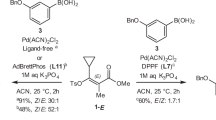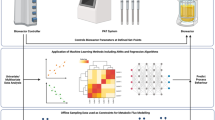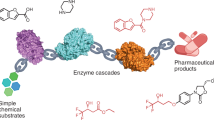Key Points
-
The means for achieving therapeutic goals resides in the active pharmaceutical ingredient of the drug used, and therefore there must be a manufacturing process capable of producing this valuable material in the quantity required, and with the high quality needed for human use.
-
The efforts required to achieve this are substantial, but, regrettably, not always seen in their full context; consequently, the challenges and frequent hardships involved are not fully appreciated.
-
This review analyses the role of process R&D in more depth, and gives some real-life examples of process development, with the aim of aiding the integration of process R&D with the rest of drug discovery and development.
Abstract
In the past, process R&D — which is responsible for producing candidate drugs in the required quantity and of the requisite quality — has had a low profile, and many people outside the field remain unaware of the challenges involved. However, in recent years, the increasing pressure to achieve shorter times to market, the demand for considerable quantities of candidate drugs early in development, and the higher structural complexity — and therefore greater cost — of the target compounds, have increased awareness of the importance of process R&D. Here, I discuss the role of process R&D, using a range of real-life examples, with the aim of facilitating integration with other parts of the drug discovery pipeline.
This is a preview of subscription content, access via your institution
Access options
Subscribe to this journal
Receive 12 print issues and online access
$209.00 per year
only $17.42 per issue
Buy this article
- Purchase on Springer Link
- Instant access to full article PDF
Prices may be subject to local taxes which are calculated during checkout








Similar content being viewed by others
References
Gerhardt, C. Untersuchungen über die wasserfreien organischen Säuren. Ann. 87, 149–179 (1853).
Federsel, H. -J. Building bridges from process R&D: from a customer–supplier relationship to full partnership. Pharm. Sci. Technol. Today 3, 265–272 (2000).
Federsel, H. -J. Drug discoverers — you need us! Drug Discov. Today 6, 397–398 (2001).
Federsel, H. -J. Start small, think big — the art of process R&D. Nature Rev. Drug. Discov. 1, 1013 (2002).
Federsel, H. -J. Facing chirality in the 21st century: approaching the challenges in the pharmaceutical industry. Chirality 15, S128–S142 (2003).
Chirality in Industry Vols I & II (eds Collins, A. N., Sheldrake, G. N. & Crosby, J.) (J. Wiley & Sons, Chichester, 1992 & 1997).
Sheldon, R. A. Chirotechnology (Marcel Dekker, New York, 1993).
Repič, O. Principles of Process Research and Chemical Development in the Pharmaceutical Industry (J. Wiley & Sons, New York, 1998).
Process Chemistry in the Pharmaceutical Industry (ed. Gadamasetti, K. G.) (Marcel Dekker, New York, 1999).
Anderson, N. G. Practical Process Research & Development (Academic Press, San Diego, 2000).
Cabri, W. & Di Fabio, R. From Bench to Market: The Evolution of Chemical Synthesis (Oxford Univ. Press, New York, 2000).
Federsel, H. -J. Development of a process for a chiral aminochroman antidepressant: A case story. Org. Proc. Res. Dev. 4, 362–369 (2000).
Centre for Medicines Research (http://www.cmr.org)
Fieser, L. F. & Fieser, M. Steroids (Reinhold, New York, 1959).
Federsel, H. -J., Jaksch, P. & Sandberg, R. An efficient synthesis of a new, chiral 2',6'-pipecoloxylidide local anaesthetic agent. Acta Chem. Scand. Ser. B 41, 757–761 (1987).
Kuhlmann, J. Drug research: from the idea to the product. Int. J. Clin. Pharm. Ther. 35, 541–552 (1997).
Trost, B. M. The atom economy — a search for synthetic efficiency. Science 254, 1471–1477 (1991).
Trost, B. M. Atom economy — a challenge for organic synthesis: homogeneous catalysis leads the way. Angew. Chem. Int. Ed. Engl. 34, 259–281 (1995).
Constable, D. J. C., Curzons, A. D. & Cunningham, V. L. Metrics to 'green' chemistry – which are the best? Green Chem. 4, 521–527 (2002).
Carlsson, E., Lindberg, P. & von Unge, S. Two of a kind. Chem. Brit. 38, 42–45 (2002).
Olbe, L., Carlsson, E. & Lindberg, P. A proton-pump inhibitor expedition: the case histories of omeprazole and esomeprazole. Nature Rev. Drug Discov. 2, 132–139 (2003).
Cotton, H. et al. Asymmetric synthesis of esomeprazole. Tetrahedron: Asymmetry 11, 3819–3825 (2000).
Federsel, H. -J. & Larsson, M. in Asymmetric Catalysis on Industrial Scale — Challenges, Approaches and Solutions (eds Blaser, H.-U. & Schmidt, E.) (Wiley–VCH, Weinheim, in the press).
Catalytic Asymmetric Synthesis 2nd ed (ed. Ojima, I.) (Wiley–VCH, New York, 2000).
Blaser, H. -U., Spindler, F. & Studer, M. Enantioselective catalysis in fine chemicals production. Appl. Catal. A Gen. 221, 119–143 (2001).
Applied Homogeneous Catalysis with Organometallic Compounds (eds Cornils, B. & Herrmann, W. A.) (Wiley–VCH, Weinheim, 2002).
Blaser, H. -U. Enantioselective catalysis in fine chemicals production. Chem. Commun. 293–296 (2003).
Wong, C. -H. & Whitesides, G. M. Enzymes in Synthetic Organic Chemistry (Pergamon, Oxford, 1994).
Drauz, K. & Waldmann, H. Enzyme Catalysis in Organic Synthesis (Wiley VCH, Weinheim, 1994).
Biotransformation in Organic Chemistry 3rd ed (ed. Faber, K.) (Springer, Berlin, 1997).
Curzons, A. D., Constable, D. C. & Cunningham, V. L. Solvent selection guide: a guide to the integration of environmental, health and safety criteria into the selection of solvents. Clean Prod. Proc. 1, 82–90 (1999).
Grubb, P. W. Patents for Chemicals, Pharmaceuticals and Biotechnology (Oxford Univ. Press, Oxford, 1999).
Author information
Authors and Affiliations
Related links
Related links
FURTHER INFORMATION
Encyclopedia of Life Sciences
Glossary
- CHIRALITY
-
The geometric property of a rigid object (or spatial arrangement of points or atoms) of being non-superimposable on its mirror image.
- RESOLUTION
-
The means applied to a racemic mixture to physically separate its constituent enantiomers.
- ENANTIOMER
-
One of a pair of molecular entities which are mirror images of each other and are non-superimposable.
- ENANTIOMERIC EXCESS
-
The percent excess of one enantiomer over the opposite enantiomer in a chiral sample.
Rights and permissions
About this article
Cite this article
Federsel, HJ. Logistics of process R&D: transforming laboratory methods to manufacturing scale. Nat Rev Drug Discov 2, 654–664 (2003). https://doi.org/10.1038/nrd1154
Issue Date:
DOI: https://doi.org/10.1038/nrd1154
This article is cited by
-
Asymmetry on large scale: the roadmap to stereoselective processes
Nature Reviews Drug Discovery (2005)



